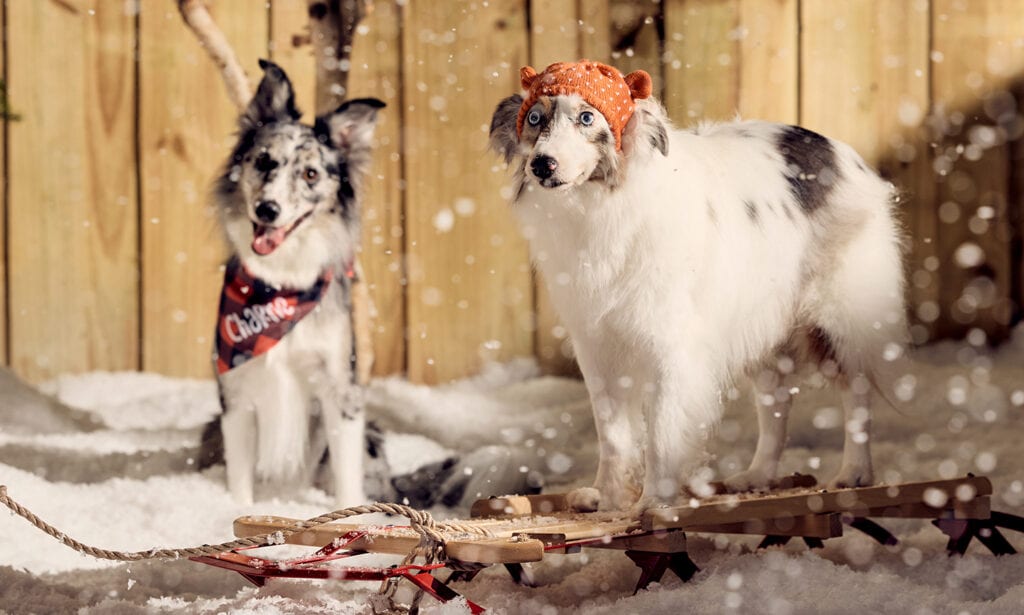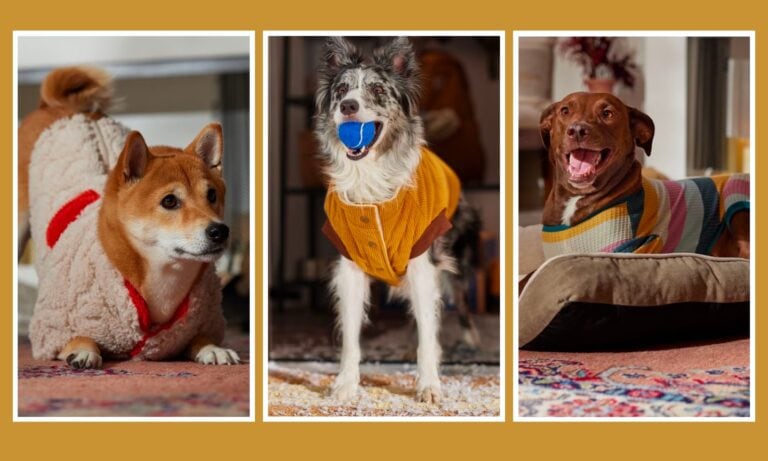If you have pups who love to spend time outdoors (we see you, sunbathers), as the weather grows colder, you're probably left wondering how to keep dogs warm in the winter outside.
Here are some effective ways to keep your pup warm while they’re exploring the great, frigid outdoors.
In This Guide:
How To Keep Dogs Warm Outside in the Winter

Place a Dog House in Your Backyard
According to the American Veterinary Medical Association (AVMA), no pet—including dogs—should be left outside for long periods of time in below-freezing weather. That said, outside dog houses, like the Trixie Natura dog house and the Frisco Deluxe dog house, are designed to give animals their own little shelter from the weather.
Typically made from weatherproof materials like wood, plastic, or vinyl, these tiny homes are designed to block wind and keep their occupants dry, says Jessica Romine, DVM, DACVIM, a registered specialist in internal medicine at Arc Vets in Auckland, New Zealand.
Here are some tips for choosing a dog house for winter:
- Make sure it’s the proper size for your pet: “The space needs to be large enough for the dog to move around and get in and out comfortably, but not too large,” Dr. Romine says. “Otherwise, it will be drafty and not contain their body heat well.”
- Opt for a raised house: “It’s important that [dog houses] don’t allow moisture in,” Dr. Romine says. “This may mean that they need to be raised to prevent mud and flooding and checked routinely during rain and snow to monitor for leaks.”
Once you’ve chosen one, add insulation. “Clean, dry straw can be a good base, as well as blankets and/or beds to allow for nesting,” Dr. Romine says.
Lastly, remember: Because dogs are susceptible to frostbite and hypothermia, they should be kept inside during cold weather. Don’t leave your pet outdoors for long periods of time.
Lay Out Heated Beds and Self-Warming Pads

For outdoor dogs who prefer a little extra warmth, heated beds, like K&H Pet Products Thermo Snuggly Sleeper, can be an option—but they may not be practical for every family, Dr. Romine says.
“The biggest concern is that these do require electricity, which may not be safe or practical in an outdoor setting,” she explains. “If one is used [inside their pet house], be sure that there is room for the dog to be in the house without being on the bed, so they can opt to not use it if they get too hot.”
A more practical choice, Dr. Romine says, is a self-warming pad.
“With self-warming pads, the pet’s own body heat is reflected back, conserving that warmth,” she says. “These may be a great option, because there is no external power requirement.”
Options include the Frisco Self-Warming Reversible Mat and the K&H Pet Products Self-Warming Crate Pad.
Wrap Them in a Winter Coat
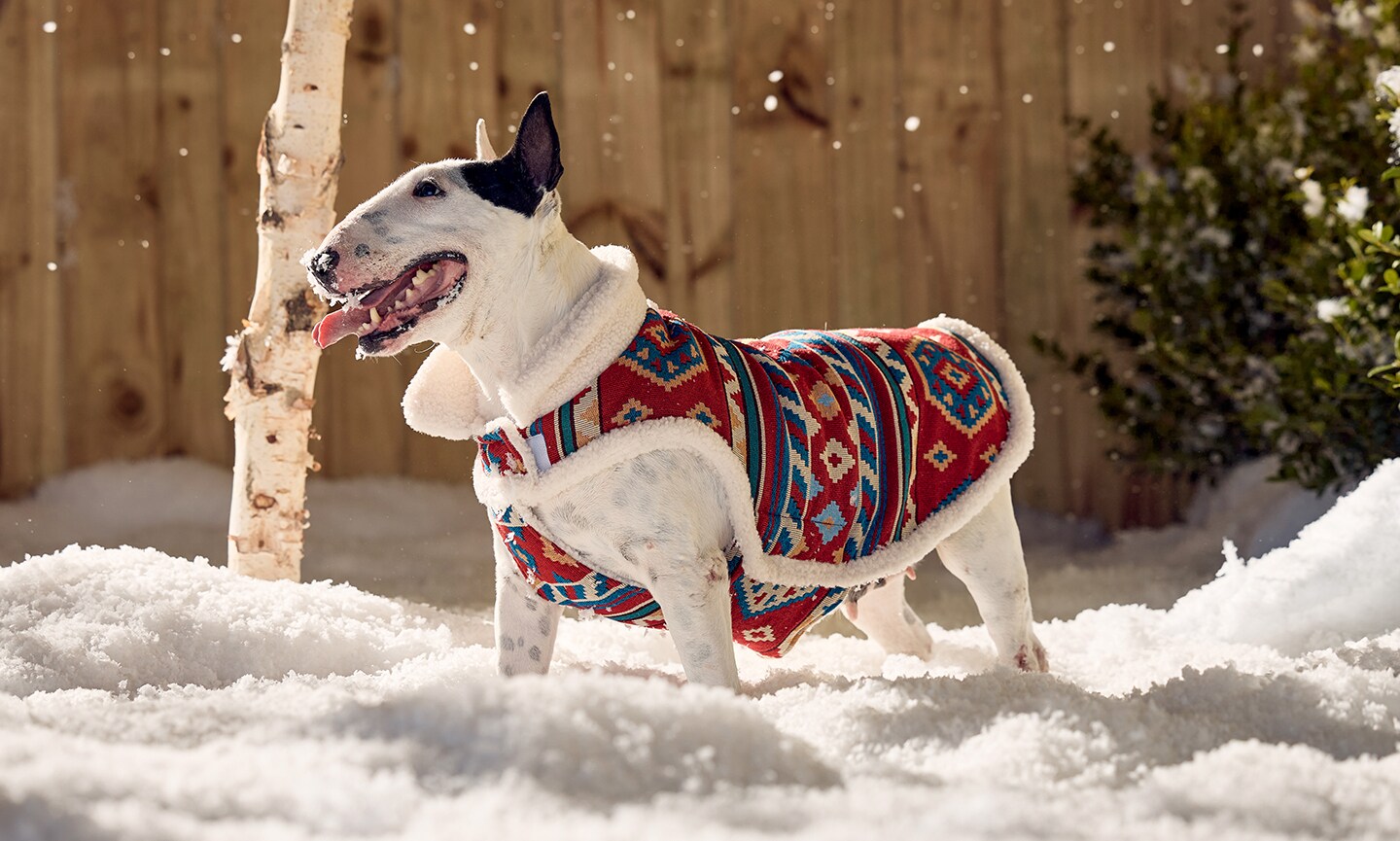
It might seem logical to wrap your outdoor-loving dog in a thick winter coat, like the Frisco Mid-Heavyweight Portland Insulated Dog & Cat Parka, or rain slicker, like the Kurgo Halifax Dog Rain Shell, but Dr. Romine suggests you only do so when you’re taking your pals out for supervised playtime or a jaunt through the snow.
“Jackets and coats can be very useful to keep dogs warm when they are going on walks,” she says. “Dogs who have been allowed to acclimate well to colder weather usually develop a nice thick undercoat and often do not need additional layers, but dogs who are predominantly indoors may need some protection, particularly in wet weather.”
Other dogs that may benefit from winter coats include dogs with a large amount of body surface area and thin hair coats, like Greyhounds. “They may benefit more than fluffier breeds like German Shepherds,” Dr. Romine says.
Do not leave harnesses, jackets, or coats on your dog when they aren’t supervised.
“I’ve seen dogs chew straps off and swallow them, requiring emergency surgery to take out,” Dr. Romine says. “They can also get them partially off, risking choking.”
Have Them Grow Out Their Fur
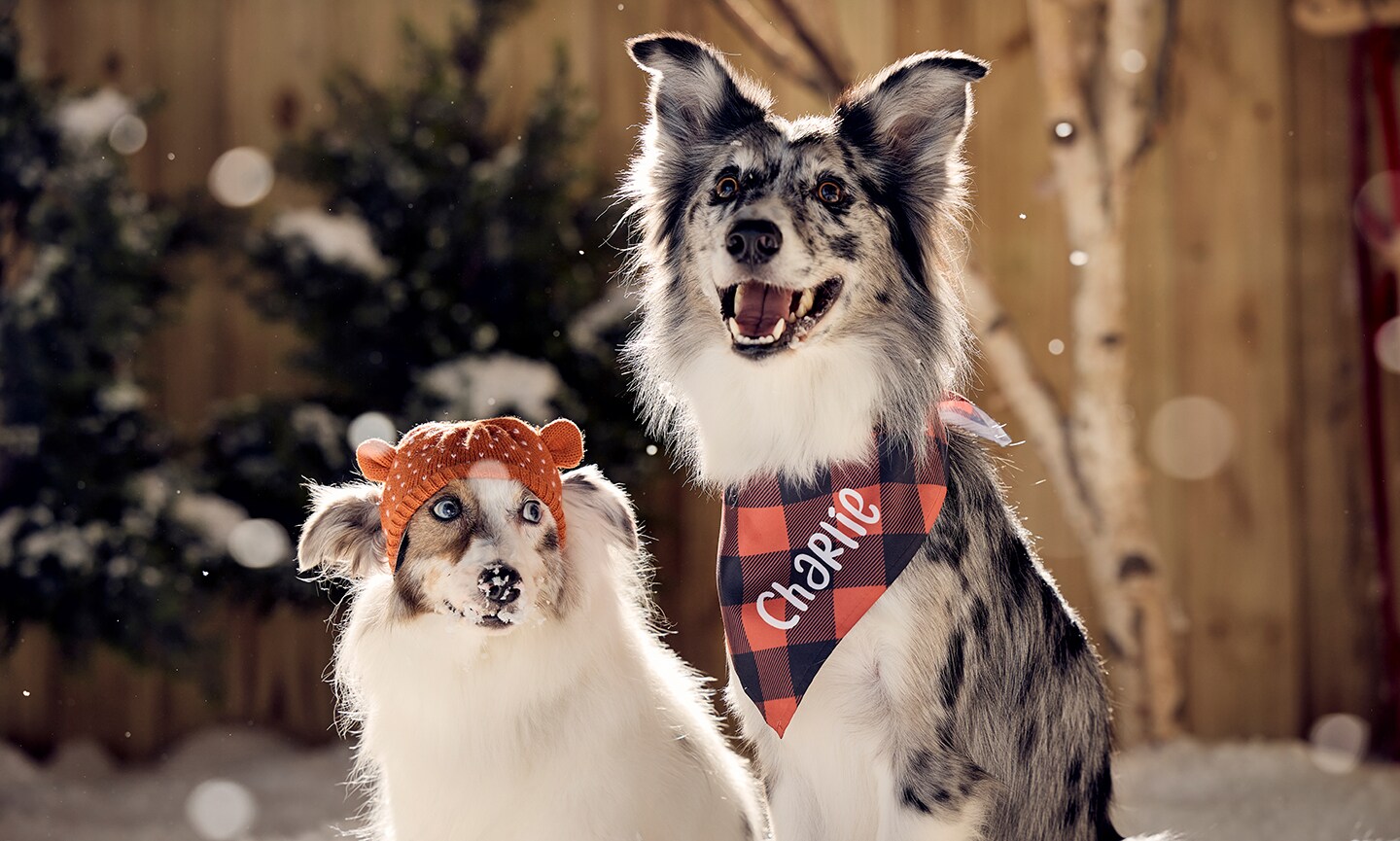
Speaking of winter coats, because the haircoat of a dog is an all-natural insulator, Dr. Romine encourages pet parents to let the fur grow during the cold weather months—especially if their pal has a double coat.
“Dog hair is a wonderful insulator, and many breeds have a double coat, with an outer layer of guard hairs to protect from the elements and a downy underlayer to contain heat,” she says. “Ideally, dogs will be allowed to grow their full coats, and dogs with routine exposure to the cold weather will adapt to a greater degree than those kept nearly exclusively indoors.”
Depending on the breed, this may require more frequent brushing to prevent painful knots and matted hair.
Keep Them Hydrated and Their Bellies Full

Staying well hydrated and belly-filled in cold temperatures can help outdoor dogs keep warm too, Dr. Romine says.
Keep the following water- and food-related tips in mind:
- Make sure their water dish doesn’t freeze. In frigid areas of the country where water in a dish frequently freezes into an ice cube, pet parents should check it regularly to ensure their dog has access to fresh, liquid water.
- Check water supplies at least twice daily to be sure the supply isn’t frozen, knocked over, or contaminated.
- Consider a heated water bowl. “Heated water bowls are available but watch the quality of the electrical cord. Be sure the outlet and cord are protected from moisture, and that [your pet] cannot chew the cord,” Dr. Romine says.
- Feed them a little more food. Because dogs expend more energy as they’re keeping their body warm, consider adding a bit more kibble to their diets, Dr. Romine says. To make sure you’re giving your pals enough calories, ask your veterinarian for specific feeding recommendations.
“Most dogs, for example, are most comfortable between about 65 degrees F and 85 degrees F,” Dr. Romine says. “Below about 65 degrees F, dogs will have to spend some energy to maintain their body heat.”
On average, the metabolic rate increases by about five calories per pound of body weight per degree F (about 10 calories per degree C) if they are inactive or resting, Dr. Romine adds. “That means they might have up to a 100% increase in metabolism if left in 40 degrees F weather for a prolonged period of time.”
How Cold Is Too Cold for Dogs?
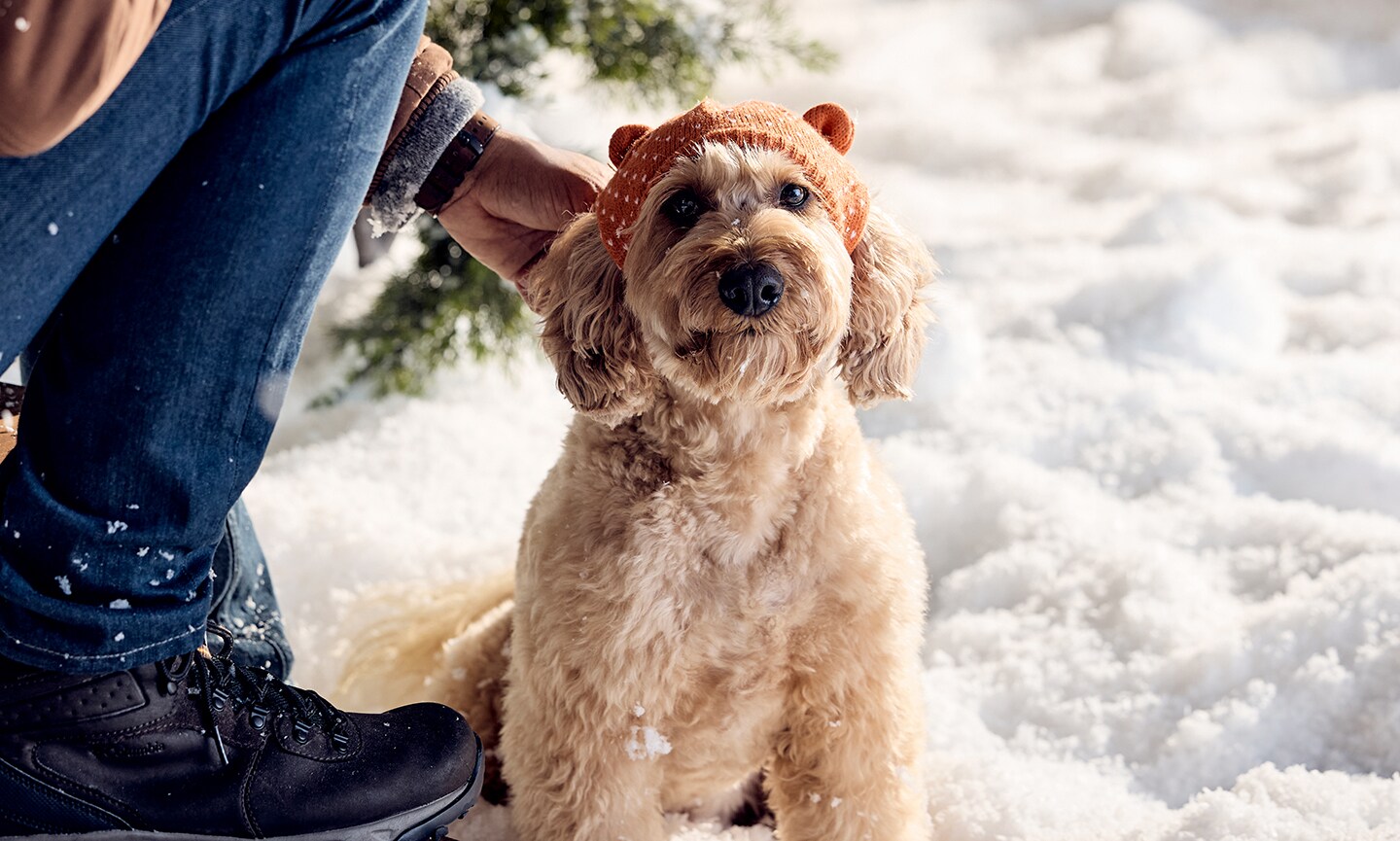
Your dog might start getting uncomfortable between 40–50 degrees F, but below 20 degrees F is when you can come across potentially serious problems, says Robert Gonzalez, DVM, a veterinarian at Veterinary Emergency Group (VEG) in New York City. Cold-associated health problems can include hypothermia or frostbite.
“In general, pets ideally should have access to indoor shelter below about 50 degrees F, so they can choose a warmer environment if they are getting cold,” Dr. Romine says.
“Too cold” depends on the breed, age, and size of your pet:
Dog Size
Small dogs will become colder sooner, and older dogs will have a harder time maintaining their body heat. Breed will also dictate their body type, body fat, and haircoat.
“Usually, smaller breeds, such as a Maltese or Yorkie, tend to have thin fur and are more sensitive to cold,” Dr. Romine says. “Greyhounds also have very little body fat and thin fur and, as such, are very susceptible to cold temperatures.”
Dog Breed
A dog’s breed will dictate their body type, body fat, and haircoat.
Northern breeds, like the Siberian Husky, Alaskan Malamute, Saint Bernard, and Bernese Mountain Dog, among others, for example, have a thick coat of fur, making them better equipped for spending time outside in the winter.
Dog Age
Dogs of a certain age may be less likely to tolerate the cold, Dr. Gonzalez says. This may be because of age-related muscle loss, decreased metabolism due to age, and/or arthritis, which can be exacerbated by the cold, he says.
Location
Previous exposure to cold weather can also impact your dog’s tolerance to it. For example, Dr. Gonzalez says that a dog who grew up in Maine is more likely to tolerate colder temperatures than one who spent a large portion of their life in Florida.
“Pets will also be less tolerant of the cold in wet weather,” Dr. Romine adds.
If you suspect your pet has hypothermia or frostbite, consult your veterinarian immediately.
Signs Your Dog Is Cold

So how can you tell if your dog is too cold? Keep an eye out for the following signs:
- Shaking or shivering
- Whining
- Seems anxious
- Slows down or stops moving
- Seems weak
- Seeks places for shelter
These are also the signs of hypothermia in dogs, according to the AVMA. Hypothermia is when a dog’s body temperature is significantly lower than normal. Hypothermia is not the same as being too cold, but it is a possible risk of keeping a dog outside in frigid weather for too long.
This content was medically reviewed by Kelly Gold, DVM, Chewy veterinarian.
More winter safety tips for dog parents:
Share:
